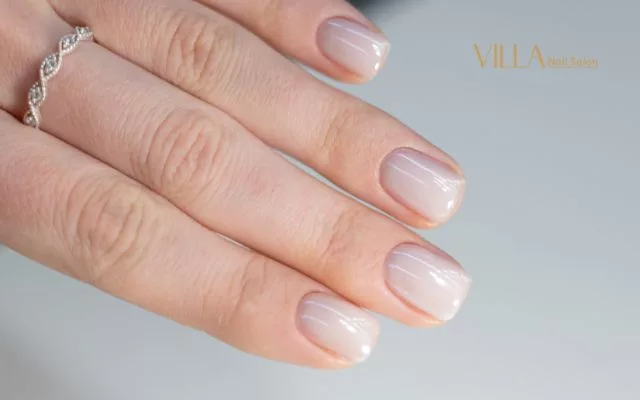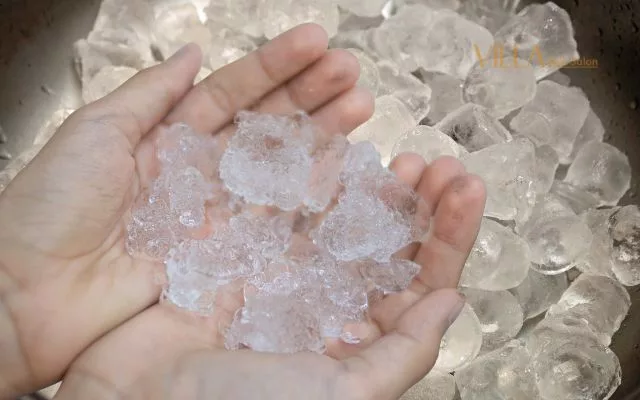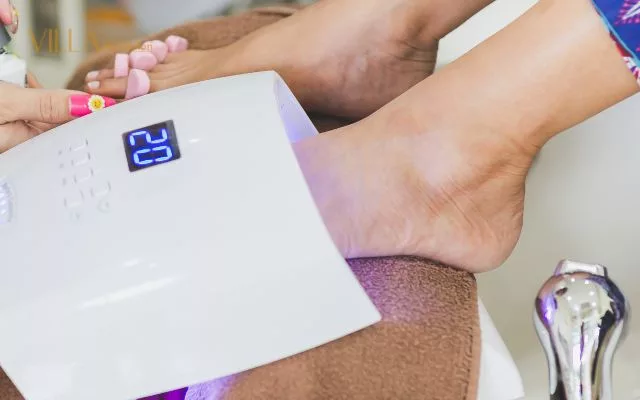Gel nail polish has taken the beauty world by storm, offering a pristine and long-lasting manicure option that’s hard to beat. With its chip-resistant and smudge-free qualities, it’s no wonder that gel polish is a top choice for those seeking a flawless and lasting aesthetic.
Table of Contents
ToggleBut what happens if you’re lacking a UV or LED lamp to cure your gel polish? Can gel polish air dry on its own, or are there alternative methods to achieve that picture-perfect finish? Let’s delve into the world of gel polish and explore various drying techniques to ensure your nails stay fabulous without the need for UV light.

The Benefits of Gel Nail Polish
Gel nail polish has garnered immense popularity due to its numerous benefits. Beyond its impressive longevity—lasting up to two weeks or more—gel nails offer a range of advantages that elevate them above traditional polish. The unique composition of gel nail polish allows for vivid colors and remarkable durability. Its hard texture forms a protective shield over natural nails, guarding against daily wear and tear that can lead to chipping and breakage.
Moreover, gel polish delivers a glossy, smooth finish that remains intact for an extended period, especially when sealed with a gel top coat. Unlike regular polish that requires patience during air drying, gel nails set quickly under UV light. This attribute not only minimizes smudging and dents but also enables easy touch-ups, ensuring your manicure remains flawless. The range of available gel polish colors allows for creative expression without worrying about staining or pigmentation issues.
The Curing Process of Gel Polish
Gel polish requires a crucial step in its application: the curing process. This step is essential for ensuring the longevity and durability of your manicure. Curing involves using a UV or LED lamp to emit ultraviolet light, which activates the ingredients in the gel polish formula. Through this process, solvents in the formula harden and create a strong bond that resists wear.
When using a UV lamp for curing, both the underside and top of the nails require exposure to ensure even curing. Skipping this step can lead to subpar results, as the formula’s ingredients won’t fully dry and harden. Proper curing safeguards your natural nails while providing a sturdy foundation for the gel polish to adhere to.
Comparing LED and UV Light for Curing Gel Polish
A common question in the world of gel nails is whether LED or UV light is superior for curing. LED light is the favored choice in many nail salons due to its energy efficiency and lack of heat emission. This type of light offers a rapid drying process, perfect for salon appointments, and boasts an impressive lifespan of up to 30,000 hours.
On the other hand, UV light requires more energy but cures gel polish faster, albeit emitting more heat in the process.
Although UV light is quicker, both LED and UV light effectively cure gel polish. The choice between them ultimately depends on your preferences and time constraints. LED light is gentle on the skin and more energy-efficient, while UV light offers a speedy cure.
With both options, your gel nails will achieve the desired durability and shine.
Can Gel Polish Air Dry?
Gel polish cannot air dry on its own, and avoiding the curing process leads to smudging, chipping, and reduced durability. Furthermore, uncured gel polish provides an ideal environment for bacteria and fungus growth, posing potential health risks.
Without UV light, the gel polish remains soft and prone to damage. It won’t adhere as securely, making it more likely to chip and crack prematurely. Attempting to air dry gel polish is a gamble that compromises the longevity of your manicure and exposes your nails to potential infections.
Alternatives to UV Light for Drying Gel Polish

When you find yourself without access to a UV or LED lamp for curing gel polish, don’t worry—there are several creative alternatives you can explore. These methods might take a bit longer than the traditional UV curing process, but they can still help you achieve beautiful and long-lasting gel nails.
1. Air Drying
Some gel polishes are specially formulated to air dry without the need for UV or LED lamps. These no-light gel polishes set and harden when exposed to air, offering a convenient option for those who don’t have access to curing equipment. While air drying might take longer than UV curing, it’s a viable solution that provides a glossy and durable finish.
2. Ice Bath Method
An unexpected yet effective way to expedite the drying process is by using an ice bath. Fill a bowl or sink with cold water and add a handful of ice. Submerge your freshly polished nails in the ice bath for a few minutes. The cold temperature helps solidify the gel polish, reducing drying time. This technique is not only practical but also offers a unique cooling sensation for your nails.
3. Fan Drying
If you’re looking for a quicker drying method, try using a fan or a cool air blower. Set the fan to a low speed and direct it towards your nails. The airflow helps push away hot air from the nails, accelerating the drying process. While it might take a bit of patience, fan drying can significantly reduce the time it takes for your gel polish to set.
4. Quick-Drying Nail Polish Spray
Quick-drying nail polish sprays are designed specifically to speed up the drying process. These sprays are applied as a top coat and help seal in your gel manicure. To use, simply shake the bottle and spray it lightly over each nail. Most products take only a minute or two to dry completely, allowing you to get back to your day with a smudge-free manicure.
5. Cooking Oil Spray
A surprising alternative involves using a cooking oil spray as a quick-drying solution. After applying your gel color and top coat, apply an extra layer of top coat over the gel polish. Then, spray each finger with a cooking oil spray from about 8 inches away for around 10 seconds per finger. This method helps expedite the drying process while also providing an added layer of protection.
6. Natural Sunlight
While sunlight doesn’t replace the precise UV wavelengths needed for effective gel polish curing, some gel polishes offer “sun activated” top coats. These top coats are designed to dry when exposed to natural sunlight. While not as reliable as UV lamps, they can be a convenient option if you’re outdoors and want to encourage quicker drying.
Can You Dry Gel Nail Polish With A Hair Dryer?
While the go-to method for solidifying gel nail polish is UV-curing lights, you can, in a pinch, use a hair dryer. Set it to cool, gently breeze it over your nails after each gel coat. Pause 10–20 seconds between coats, avoiding clumps from excess heat. Patience is key; excessive heat could undo your work.
Remember, this isn’t the gold standard. It’s for times when UV light isn’t an option. Give each coat a few minutes to fully harden. Your gel manicure will last, but proper equipment is best. In the realm of nail finesse, innovation meets tradition for lasting elegance.
UV/LED Lamps vs. Alternative Drying Methods

While the alternative methods mentioned can be useful in situations where you don’t have access to a UV or LED lamp, it’s important to note that using a UV or LED lamp remains the most effective and reliable way to cure gel polish. Here’s a breakdown of what you can expect from both approaches:
Using a UV or LED Lamp
- Efficiency: UV and LED lamps are designed specifically for curing gel polish. They emit the precise wavelengths of light required to activate the curing process efficiently. This ensures that your gel polish hardens and sets properly, providing a longer-lasting and durable finish.
- Speed: UV and LED lamps offer quick curing times, often within seconds to a few minutes. This means you can achieve perfectly dry and solid gel nails in a fraction of the time compared to alternative methods.
- Consistency: UV and LED lamps provide consistent results, ensuring that each layer of gel polish is uniformly cured. This minimizes the risk of smudging, chipping, or uneven curing.
Using Alternative Methods
- Longer Drying Times: Most alternative methods, such as air drying, fan drying, or natural sunlight, generally take longer to achieve the same level of curing as a UV or LED lamp. This can result in increased waiting times and a higher risk of accidental smudging.
- Variable Results: The effectiveness of alternative methods can vary depending on factors such as humidity, temperature, and the specific gel polish brand you’re using. There’s a higher chance of inconsistency in results.
- Less Durability: While some no-light gel polishes offer air-drying options, they may not provide the same longevity and durability as gel polish cured under UV or LED light. You might experience quicker chipping and fading.
- Risk of Smudging: With longer drying times, there’s a greater risk of accidentally smudging your freshly applied gel polish. This can be frustrating and impact the overall appearance of your manicure.
Conclusion
In summary, while alternative methods can offer a temporary solution when you lack access to UV or LED lamps, they may not provide the same level of reliability, efficiency, and longevity as proper curing with specialized equipment. If you’re aiming for a professional, long-lasting gel manicure, investing in a UV or LED lamp is highly recommended. However, if you’re in a bind and need a quick solution, the alternative methods can be helpful in a pinch.
Are you after the speed and precision of professional drying, or do you prefer the potentially gentler approach of alternative options? The Villa Nail Salon blog has even more insights on this topic, so if you’re hungry for more nail care wisdom, don’t hesitate to read more and explore the world of nail art without limits. Your manicure journey is uniquely yours to craft, with options as diverse as your personal style.

